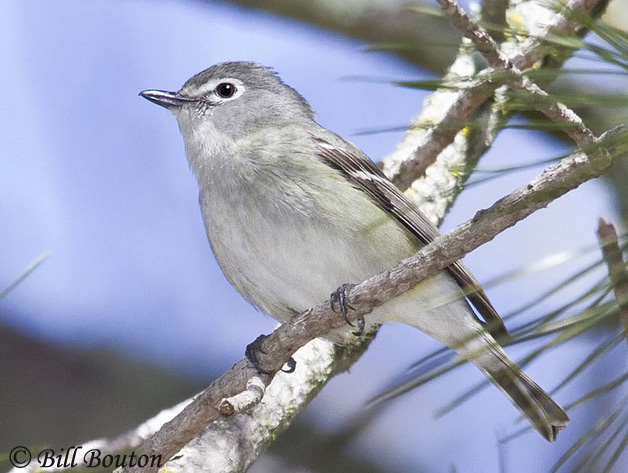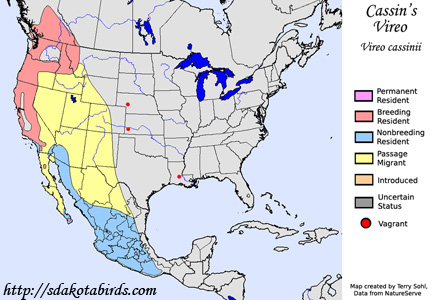| Length: 5.5 inches | Wingspan: 9.5 inches | Seasonality: Non-resident in South Dakota |
| ID Keys: White "goggles", dark gray above with olive tinge, light below, greenish cast on flanks (variable) and secondary wing feathers, two white wing-bars | ||
 The
Cassin's Vireo was, until recently, considered one species (the "Solitary
Vireo), along with the Blue-headed
Vireo and the Plumbeous Vireo.
The plumage of a Cassin's Vireo is somewhat intermediate between the more
boldly colored Blue-headed Vireo, and the drabber Plumbeous Vireo.
Each of the three species differ in their primary range and geography can be
used to help identify which of the three species is sighted, but the
Cassin's and Plumbeous Vireos do have some overlap in range in the West,
making differentiation of the two species more difficult.
The
Cassin's Vireo was, until recently, considered one species (the "Solitary
Vireo), along with the Blue-headed
Vireo and the Plumbeous Vireo.
The plumage of a Cassin's Vireo is somewhat intermediate between the more
boldly colored Blue-headed Vireo, and the drabber Plumbeous Vireo.
Each of the three species differ in their primary range and geography can be
used to help identify which of the three species is sighted, but the
Cassin's and Plumbeous Vireos do have some overlap in range in the West,
making differentiation of the two species more difficult.
Habitat: Found in open woodlands in western North America in the summer, most often in oak woodlands in the south or dry conifer forests towards the north. Can be found in a variety of woodland habitats during migration.
Diet: During the summer months, feeds almost exclusively on insects and spiders. In winter, they may augment their diet with some fruits and berries as well.
Behavior: Forages deliberately in the mid- to high-levels of the forest canopy, searching through the foliage and branches for insects. They will also sometimes fly out to capture insects in mid-air.
Nesting: The nest of a Cassin's Vireo is a cup of grasses, weeds, roots, plant down, and other fibers, placed on the branch of a tree, between 5 and 30 feet from the ground. The female lays 3 to 5 eggs, and both parents help to incubate them. Upon hatching, both parents tend to and feed the young.
Song: The song of a Cassin's Vireo is a series of whistled phrases, increasing in pitch and then descending. Also has a harsh call note.
Migration: Birds that summer in the western U.S. and Canada move southward to Mexico for the winter, with some found as far north as southern California and Arizona.
Interactive eBird Map: Click for access to an interactive eBird map of Cassin's Vireo sightings
Similar Species: Plumbeous Vireo, Blue-headed Vireo
Conservation Status: Populations of Cassin's Vireos are widespread, common in many parts of its range, and are stable or may even be increasing. The IUCN lists the Cassin's Vireo as a species of "Least Concern".
Further Information: 1) BirdWeb.org - Cassin's Vireo
2) Audubon Guide - Cassin's Vireo
3) WhatBird - Cassin's Vireo
Photo Information: Photo taken on May 2nd, 2012 by Bill Bouton, in San Luis Obispo County, California - Photo licensed under Creative Commons Attribution ShareAlike 2.0 Generic License
| Click below for a higher-resolution map |
 |
| South Dakota Status: Non-resident in South Dakota |
Additional Cassin's Vireo Photos (coming soon!!)
